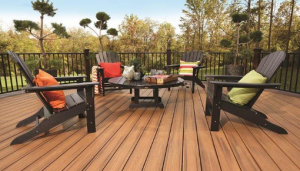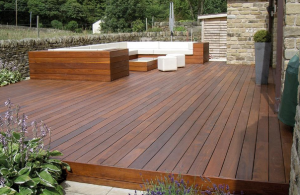Thermally Modified Wood Decking and Its Benefits?

Thermally modified wood is a traditional wood alternative that is incredibly long-lasting and can withstand harsh weather, bugs, fungi, and bacteria year after year. It is a natural, non-toxic alternative to other chemically treated wood decking options.
Thermally modified wood is 75- 85% more stable than regular wood and is one of the most sustainable, high-performance options to consider for decking. Due to the increasing environmental crisis, thermally modified wood decking is becoming popular by the day.
A thermally modified wood might cost you a bit more than other regular decking options, but it definitely has its perks that outweigh the regular chemical-infused woods.
In this article, we will discuss the benefits of using thermally modified wood for decking and why is it a good option?
What`s a thermally modified wood?

A thermally modified wood goes through a variety of processes at the cellular level to alter the wood`s characteristics, chemistry, and performance. The life expectancy of this wood is 25-30 years, much more than regular wood used for decking.
Unlike kiln drying, this wood is heated at an extremely high temperature, over 400 degrees Fahrenheit, in a controlled environment with no oxygen to prevent combustion. This process removes hemicelluloses and carbohydrates in the cell walls, modifying wood on a cellular level to prevent bacterial or fungal decay.
Thermally modified woods have a deep brown color due to the caramelization of sugars in the wood during the baking process.
Thermally modified wood is normally:
- More stable
- Relatively brittle than non-modified woods (20% more brittle)
- Rot-resistant because the high temperatures alter the sugar content within woods
Moreover, a thermally modified wood becomes water resistant, meaning it neither expands nor contracts when it comes in contact with water. Also, the absence of cellulose helps protect it from fungi, bugs, and decay for enhanced durability.
What are the benefits of thermally modified wood decking?

If you are planning on installing a deck that will survive the test of time, then check out the following benefits of thermally modified wood decking to know your options.
Strength
When wood is thermally modified, it instantly becomes sturdier and rot-resistant. Thermal modification acts as a natural seal for the wood and makes it resistant to water and moisture deformity.
Since traditional wood is quick to absorb water, it is also easily subjected to warping, discoloration, and bacterial and fungal growth. However, a thermally modified wood decking will keep this problem at bay.
Environmentally sustainable
Thermal modification of wood uses renewable resources like wood and heat only to help increase its life span. Regular uncured wood decking is susceptible to decay, fungi, and harsh weather and is chemically treated with pesticides that are harmful to the environment.
It’s a clean decking procedure that uses much less energy than traditional wood treatment procedures. Thermally modified wood will help sustain the environment because you won`t need to replace your deck for decades.
Aesthetics
Thermally modified wood decks have a natural wood finish to them. The intense temperatures intensify the natural wood color that needs no staining. However, getting your deck waterproofed would still be a good investment to make. If you want to waterproof your patio this summer, contact Capital Deck & Stair and get a free quote on the cost and services.
Chemical free
The thermal modification only uses heat to cure wood and no harmful chemicals or pesticides like regular woods. Moreover, sourcing thermally modified wood from sustainably managed forests will also help you curb the environmental impact if that`s one of your concerns.
Chemically treated woods contain:
- Pentachlorophenol
- Chromated copper arsenate (CCA)
- Ammoniacal copper (ACA)
- Creosote
- Copper sulfate
- Tributyl-tin oxide
- Zinc naphthenates
Chemically treated woods also contain a variety of pesticides that pose several health and environmental concerns. Thermally treated wood decking is a harmless option for families with sensitivities and toddlers.
Cost-effective
From its resistance to weather and insects to its cost-effectiveness, thermally modified wood decking outweighs traditional wood decking. When you factor in the list of benefits of thermal wood decking, you will find it a much more cost-effective and safe option than the rest.
What`s the best thermal modification process?

The thermal wood modification process varies significantly, and not all yield the same results. Some procedures only include heat,
while others use other materials like oil and water to retain the strength of the wood. Heating the wood alone can make it brittle and lead to split ends. Also, cooking the wood speedily can significantly lower its durability and quality. This is why the most effective way to modify a wood thermally is ThermoWood.
ThermoWood
ThermoWood process is the most renowned way of thermally modifying soft and hardwoods. It was developed 30 years ago in Finland, and today we use its most refined and improved form.
In this process, the wood is modified by using only heat and steam, with no chemicals or toxins whatsoever. The water keeps the wood from drying out too quickly and yields a higher-quality finished product. ThermoWood is the most effective procedure for hardwoods like alder, oak, teak, etc.
Take away
Thermal modification of wood is a well-established wood decking technique for improving the stability and durability of the wood. Thermally treated woods have immense benefits in terms of being resistant to weather and fungal rot. It is one of the most cost-effective and environmentally stable procedures that only uses heat and water, unlike regular chemically treated decking woods.
If you are an environmental enthusiast planning on getting a deck for your house, then thermally modified wood would be the safest option.
RECENT POSTS
categories
- Uncategorized
- Waterproofing
- Stair Tread Replacement
- FAQ
- Balconies
- Precast Iron Stairs
- Outdoor Stairs
- Leisure Deck
- Deck Resurfacing
- Pool Decks
- Deck Maintenance
- Deck Staining
- Deck Materials
- Nonslip Deck Coatings
- Fiberglass Stairs
- Gardening
- Deck Repair
- Patio Waterpoofing
- Commercial waterproofing
- Concrete Waterproofing
